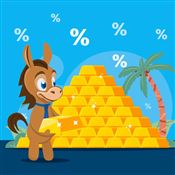Gold IRA vs Physical Gold
You can invest in gold through physical coins or a Gold IRA. But which is better for your goals? Let's break it down.
 |
The price of gold has already doubled in the last 10 years. Considering scarcity and the increasing challenges in mining, gold remains an attractive investment for those who want to expand their portfolio beyond stocks.
There are many ways to invest in gold, but the two most common include buying it physically or through a Gold IRA.
Not sure what's best for you? This review will cover the costs, requirements, and terms for both methods.
Should You Buy Physical Gold Or A Gold Ira?
- Buy physical gold if you want direct access to your gold coins or bars with the freedom to sell them anytime.
- Choose a Gold IRA if you're investing for retirement and would prefer investing in gold with tax advantages. You can directly move your 401k to a Gold IRA penalty-free.
Here's a quick comparison of the two:
| Physical Gold | Gold IRA | |
|---|---|---|
| Minimum investment | No minimum invesment | Minimum $10k to $50k |
| Purchase | Direct store purchase | Gold IRA account required |
| Types of gold | All types of gold | Select IRS-approved gold with 99.5% purity |
| Sale terms | Can sell at anytime | Penalty-free withdrawals only allowed after age 59-1/2 |
| Required withdrawals | No required withdrawals | Required minimum distributions at age 73 |
| Storage | Storage depends on you | Storage in an IRS-approved depository |
| Taxes | Purchased with post-tax dollars and subject to capital gains tax | Tax-deductible contributions (Traditional Gold IRA) or tax-free withdrawals (Roth Gold IRA) |
| Fees | Shipping fee and optional storage fees | One-time setup fee, annual storage fee, and annual admin fee |
Keep reading to learn about these in more detail.
Investing In Physical Gold
When you invest in physical gold, it means you're buying gold bars or coins directly from precious metals dealers. You can then store them anywhere at your own discretion.
Some investors prefer to store their gold at home in a safe, while some prefer to pay extra to lease a safe deposit box along with insurance.
There's this old saying, "If you don't hold it, you don't own it."
Despite modern ways to invest in gold, some still prefer to own it physically. This way, investors are assured that they can sell their gold anytime they need it, especially in cases of economic uncertainty.
Drawbacks:
You'll have to pay normal capital gains taxes and will not enjoy any tax advantages, unlike Gold IRAs. You're also fully responsible for keeping your gold safe.
Pros & Cons:
|
|
Investing In Gold IRA
In a Gold IRA, you're buying physical gold as part of a retirement account. So there are more rules.
To invest in gold, you'd need to set up an account with a Gold IRA company first. The Gold IRA company will then handle all the purchasing, storage, and even distribution of your asset in exchange for a fee. But you have full control over your investments.
Just like regular IRAs, you get tax benefits. The value of your gold grows either tax-free or tax-deferred. This makes it an attractive option compared to just buying gold directly.
Drawbacks:
You cannot store your gold on your own under a Gold IRA. You must store it in an IRS-approved depository. In fact, if the IRS discovers that you are holding your IRA assets, you may even be fined.[1]
And similar to regular IRAs, if you withdraw early before age 59-1/2, you'll be subject to a 10% penalty.[2]
You're also limited to what coins you can buy (ex: no collectibles). Gold IRA companies also require a relatively high minimum investment of $10,000 to $50,000.
Pros & Cons
|
|
Gold IRA Company Integrity Checklist
Free report and checklist that helps consumers compare and choose a reputable gold IRA company
Free Gold IRA Kit
- Up to $10,000 in free silver for eligible customers
- Highest buyback price, guaranteed
- Endorsed by Sean Hannity and Chuck Norris
Detailed Comparison
So, how exactly are Gold IRA and physical gold investing different? Continue reading.
The value of your Gold IRA will only increase if the spot price of the gold also increases. Gold IRAs do not pay any regular dividends to investors.
Fees
Expected fees for physical gold:
- Premium on gold spot price
- Market loss fees (if canceled)
- Shipping fee (in many cases, can be free)
- Optional storage fee
Overall, you'll pay lower fees when you directly buy physical gold compared to a Gold IRA.
With physical gold, you only have to pay for the seller's mark-up. Shipping fees can even be free with some dealers. But if you cancel an order, you'll usually pay a market loss fee.
Depending on how you store your gold, you don't have to spend a lot. You could buy a safe for your house or lease a safe deposit box.
Expected fees for gold IRA:
- Premium on gold spot price
- One-time account setup fee
- Annual account admin fee
- Annual storage fee
In a Gold IRA, you need to pay a one-time account setup fee, an annual account admin fee, and an annual storage fee. They typically range from $200 - $300 a year.
These fees are usually fixed regardless of whether you invest $25,000 or $100,000. So essentially, the more you invest, the lower the percentage of annual fees you pay.
The fees you need to pay will depend on your Gold IRA company, but here's the general range:
- Minimum investment: $10,000 - $50,000
- One-time account setup fee: $50 - $150
- Annual account admin fee: $100 - $150
- Annual storage fee: $100 - $300
Ease Of Purchase
How to purchase physical gold:
- Go to a gold dealer's website
- Select your gold products
- Process payment
- Wait for delivery
It's easier to start investing in physical gold than a Gold IRA.
Buying physical gold is as easy as online shopping. You visit the website of a precious metals dealer, select a product, pay for it, and wait for it to be shipped to your address.
How to invest in a Gold IRA:
- Open a self-directed IRA account with a Gold IRA company
- Fund your account with new money or roll over from a 401(k) or other existing retirement account
- Select your gold products
- Gold IRA company buys on your behalf and stores for you
A Gold IRA has a few extra steps. You need to find a Gold IRA company first, set up an account with them, and transfer money or rollover your 401k. The Gold IRA provider will help with the rollover paperwork.
After funds are transferred, you can select the gold you want, and the company will buy and store it for you.
With physical gold, you can buy whatever amount you want, with no minimum required. If you only want to buy one gold coin, that's fine. But in a Gold IRA, companies will have a minimum investment, which ranges from $10,000 to $50,000.
Types Of Gold
With physical gold investing, you can buy any type of gold you want.
However, when investing in a Gold IRA, the IRS only accepts certain gold that meets purity standards (called "bullion"). This way, its price is more standardized and easily quantifiable. Some rules are:
- Must be at least 99.5% pure gold, except for the American Gold Eagle coin, which is 91.67% pure
- Minted by a national government
- Cannot be a collectible coin
The IRS has a list of approved gold that can be invested in Gold IRAs. This includes:
- American Gold Eagle
- American Gold Buffalo
- Canadian Gold Maple Leaf
- Canadian Gold Eagle
- Canadian Gold Polar Bear & Cub
- Australian Gold Striped Marlin
- Australian Gold Kangaroo
- Austrian Gold Philharmonic
- Chinese Gold Panda
Liquidity & Withdrawals
Liquidating physical gold:
- Sell to a physical metals dealer
- Stores may require a minimum amount, such as $1,000, or a minimum quantity of 1 ounce
- You ship the metals on your own (unless it's in a depository)
You can sell your physical gold whenever you want at any precious metal dealer. However, most of them require a minimum amount or quantity.
You're also responsible for shipping it to the dealer. You will only be paid once they've received and inspected the gold. If it's in a depository, you can still sell it, but you no longer have to worry about shipping.
Withdrawing from Gold IRA:
- Penalty-free withdrawals are only allowed after age 59-½
- Early withdrawal penalty of 10%
- Minimum required distributions (RMDs) starting at age 73
[3]
- Distribution in the form of gold or cash
As for the Gold IRA, you're expected to hold it for a long time. Any withdrawals before age 59-½ will have a 10% penalty, unless it's a valid exception such as higher education expenses, medical expenses, emergency expenses, etc.[4]
When you reach the age of 73, you're also required to start withdrawing according to the required minimum distribution (RMD) rules.
For example, at age 73, your distribution period is 26.5 years according to the Uniform Lifetime table provided by the IRS. To find your RMD, divide your account balance as of December 31 of the previous year by 26.5.[5]
To withdraw from a Gold IRA, simply reach out to your custodian. You can choose to take the distribution as physical gold or cash.
Storage and Maintenance
You get full discretion on where to store your gold if you bought it physically. Some of the most common options include buying a safe in your home or renting a safe deposit box. You also might want to consider getting separate insurance.
With a Gold IRA, your provider will store the gold on your behalf at an IRS-approved depository. You cannot store IRA gold at home.
The depository will depend on the partners of your chosen IRA company, but some of the notable ones include Brink's and Delaware Depository.
No, you cannot store the physical gold yourself if it's bought through a Gold IRA. You need to store it in an IRS-approved depository, who will manage it until its distribution.
Tax
You'll pay ordinary tax on physical gold without tax advantages. The rate would depend on whether it is a long-term gain (held for 1 year or more) or a short-term gain. Since gold is classified as a collectible, the maximum long-term capital gains tax rate is 28%.[6]
With Gold IRAs, the biggest benefit is that you get tax advantages. In a Traditional Gold IRA, your contributions are tax deductible in the year it was made. But you'll pay income taxes when you withdraw.
With a Roth Gold IRA, your contributions are made with post-tax dollars. But all qualified distributions and earnings are tax-free.
Gold IRAs are tax-deferred, so you don't pay tax until it is distributed at the end. You can also invest in a Roth IRA with after-tax funds, enabling you to enjoy tax-free withdrawals in retirement.
Getting Started
Ready to get started? Here's a quick guide on where you can start investing through physical gold or Gold IRA.
These are some of the stores where you can buy physical gold:
While here are some of the Gold IRA companies that can help you start investing:
Free Gold IRA Web Conference
- Free 1-on-1 web conference designed by an on-staff, Harvard-trained economist
- Lifetime support even after your purchase
Free Gold IRA Kit
- Up to $10,000 in free silver for eligible customers
- Highest buyback price, guaranteed
- Endorsed by Sean Hannity and Chuck Norris
Free Information Kit
- Free "insider" info on gold & silver
- 1-on-1 care with a dedicated specialist
- Endorsed by Ben Shapiro and Ron Paul
Free Investors Kit
- A+ Rating from BBB, 5-Star Reviews and Thousands of Satisfied Clients
- Exclusively Recommended by Bill O'Reilly, Rick Harrison and Others.
- No-Cost Consultation with a Precious Metals Specialist
Bottom Line
Investing in physical gold or Gold IRA depends on your investment goals. If you're looking to invest in gold for retirement, then a Gold IRA may be a good option since you get tax benefits.
However, some investors would prefer to hold their own gold and store it somewhere closer to them. If you like the assurance of physical gold that you can liquidate at any time, then it's best to buy gold coins outside of an IRA.
References
- ^ The Wall Street Journal. Couple Stored IRA Gold at Home. They Owe the IRS More Than $300,000, Retrieved 05/09/2024
- ^ Internal Revenue Service. IRA FAQs - Distributions (Withdrawals), Retrieved 07/08/2024
- ^ Internal Revenue Service. Retirement plan and IRA Required Minimum Distributions FAQs, Retrieved 07/08/2024
- ^ IRS. Retirement topics: Exceptions to tax on early distributions, Retrieved 05/09/2024
- ^ Internal Revenue Service. About Publication 590-B, Retrieved 07/08/2024
- ^ Internal Revenue Service. Topic No. 409 Capital Gains and Losses, Retrieved 07/08/2024
Write to Stella Magay at feedback@creditdonkey.com. Follow us on Twitter and Facebook for our latest posts.
Note: This website is made possible through financial relationships with some of the products and services mentioned on this site. We may receive compensation if you shop through links in our content. You do not have to use our links, but you help support CreditDonkey if you do.
|
|
| ||||||
|
|
|
















